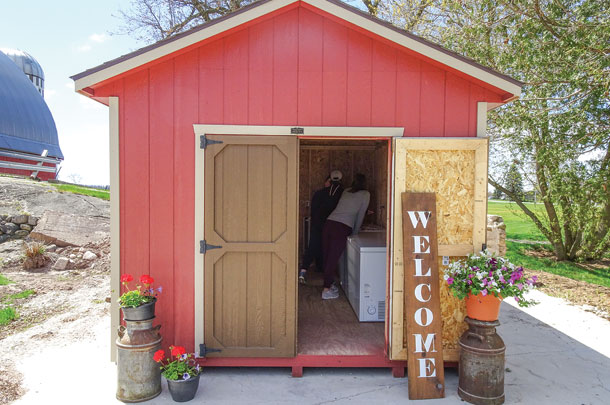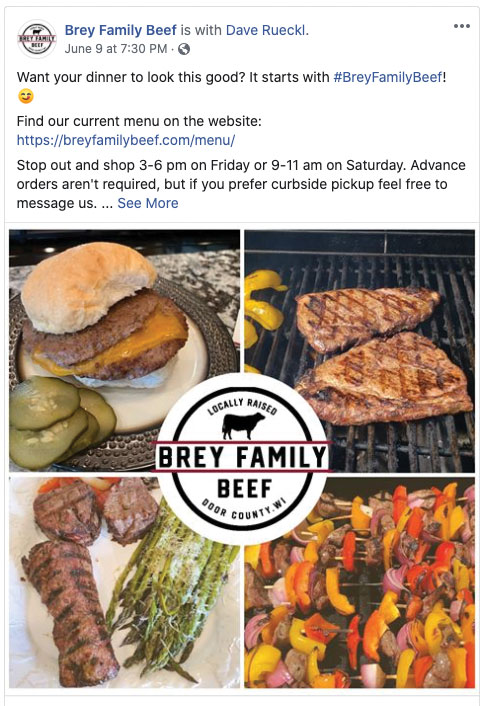As that market changed, we changed our breeding strategy.
Now that influx of beef animals is ready for harvest. This could be viewed as a blessing or a curse. COVID-19 has rattled our supply chain. Therefore, our original plan to wholesale our animals to major meatpacking plants in our area had to shift, and quickly.
We decided to view this as an opportunity to provide quality meat during a time when stores are in short supply and consumers are looking for ways to still keep beef on the table. In just a month’s time, Brey Family Beef went from concept to reality.
Sharing our resources
“To learn and grow so that all may prosper.” That’s our mantra, or our “why” at Brey Cycle Farm. For us, “all” is our families, our employees and our community.
Connecting our resources, like our home-raised beef, with our “why” is what personally fills my soul. This winter, I felt the urge to show our daycare providers how much they mean to us. So I offered them beef at a very reduced cost. The outpour was amazing. These people who take care of my children were so thankful. What’s more, one of the resounding comments was that they just didn’t know where to go to get locally raised beef. As farmers, we take this resource for granted. Our goal in this new venture is to meet the needs of everyone.
Now we’re set up to provide a needed product to our community. What’s more, our presence will provide another touchpoint with consumers. This pandemic has created a lot of things; one of which is, hopefully, an opportunity for people to appreciate where their food comes from.
Setting up our direct beef business
We moved forward quickly to set up our direct beef business, applying for a meat sales license from our state department of agriculture, securing spots at our local inspected butchering facilities and buying freezers where we could find them.

My sister-in-law, Lauren Brey, put her marketing and communications skills to work. She created our Brey Family Beef Facebook page and Instagram, and directed the construction of our website. Social media has been our primary form of advertising, and we are beginning to try out some local radio ads as well.
Packaging
Farmers are used to having multiple freezers full of meat. However, the average consumer doesn’t have that space. Nor do many have the financial ability to invest in half or quarter of a cow at a time. While we feel that efficiency is important for our time and efforts, we know some need smaller packages. Therefore, in our retail sales, we’re aiming to offer packages that meet different price points.
Ground beef is a staple in many households, so we aim to always have that available at a fair price. If someone wants to come every week and buy 2 pounds of ground beef, we will have that for them each week. For those who want to scratch the itch of a nice steak while their favorite restaurants are closed, we will have larger packages that include a variety of cuts. This helps us with our inventory tracking and preparation for store hours.
Ordering and pickup
So far, our store hours are limited, with many people ordering up-front through email or Facebook Messenger. This has allowed us to devote time to Brey Family Beef when it works for us. After all, we have a 600-cow, 1,300-acre dairy and heifer-raising business to run. Additionally, we have children, and my sister-in-law has a full-time off-farm job.

Prior to the designated pickups, we post a menu of the upcoming weekends’ offerings.
Pickup is right on the farm. So far, we’ve done payment transactions using cash, check or the Venmo app. We have not yet set up a credit card option, as our customers thus far have not requested it. For us, this also helps to avoid card processing fees.
Pivoting to promote dairy
Promoting dairy is also a primary goal of our little venture. Each week, we will feature a dairy product to introduce consumers to different dairy products made from our milk. During our first few weekends, we gave each customer a 3-ounce bag of fresh cheese curds from the local cheese store where our milk is processed. We received pictures of people enjoying them on their way home and even using as garnish in their bloody Marys.
Our Memorial Day Special aimed to entice people to enjoy cheeseburgers. We included a pound of freshly sliced cheddar cheese with each 20-patty burger purchased. Again, cheese comes directly from the creamery where our milk goes, so it’s a way to showcase our product and entice people to make those burgers into cheeseburgers.
Reaching out, giving back
Not only will this venture allow us to reach consumers – it will also provide us an avenue to give back to the community. Donating milk and cheese to local events has been a normal practice for us. Providing beef to our church picnics, fair food stands and even food pantries will take that philanthropic opportunity even further. ![]()
PHOTO 1: The team at Brey Cycle Farm includes brothers Tony and Jacob Brey; their wives, Moriah and Lauren; and a number of valued employees and vendors. Pictured here from left to right are Jacob and Lauren Brey; Moriah, Alexa (3), Evan (8) and Tony Brey.
PHOTO 2: To comply with state regulations for selling beef off of their farm, the Breys keep their retail cuts in freezers in this small shed.
PHOTO 3: The Brey Family Beef advertises packages available for weekly order and pickup through social media posts like this. Courtesy images.
Moriah Brey is part of team Brey Cycle Farm. Email Moriah Brey.
Thinking about a direct-beef marketing business?
Answer these 10 questions.
The following 10 questions provide a framework for setting up a direct-to-consumer marketing option for farm-raised beef.
1. What licenses and permits do you need?
This varies by state, so check with the respective state’s department of agriculture. In Wisconsin, it requires applying for a retail food license. This includes allowing a state or local health official to complete an inspection. This inspection confirms the farm has a dedicated freezer for salable beef, with a thermometer verifying the freezer can maintain 0ºF or less and is located away from living quarters and separate from anywhere vehicles are regularly parked.
2. How many head are ready for market?
For example, a Holstein-Angus cross finishes at around 1,400 pounds. Do you have a group of cattle set to finish around the same time? Make sure you have freezer capacity available.
3Who will process the animals?
Contact licensed meat processors as soon as possible as, in some regions, these may be hard to find or booked out for several months. Have an open conversation with the processor about your plans for your beef. Processors may have different accreditations or licenses – for instance, if a processor has a custom slaughter license, they may butcher quarters/halves for you, but the individual packages wouldn’t be legal for resale.
4. How will beef be cut and packaged?
Evaluate the cutting order options. For ground beef, consider a mix of pre-made patties and 1-pound tubes. Choose the packaging options, i.e., butcher paper, plastic, vacuum sealing.
5. How will you set retail prices?
This, of course, depends on what your goals are. For us, this venture is a mix of opportunity and a want to give back to our community. As a “retired” Farm Credit credit analyst and the money manager of our farm, I know that money matters. I would suggest knowing your input costs and setting a price from there. You’re not the grocery store – so you don’t have to meet their prices – on the low or high side.
Our goal is to be consistent and fair. The market in general is crazy right now – ground beef prices are sky-high while high-end cuts can be found for a deal. This is all thanks to the disruption COVID 19 has had on our supply chain. It’s easy to get caught up in this if you don’t have a solid plan. We’ve figured our costs and know our why. Therefore, we will always price our beef fairly and will not ebb and flow with the crazy market. This allows us to feel good about what we’re offering and know we’re helping others.
6. How will you market your beef?
Determine how people will know they can buy beef directly from you. Social media can be an effective tool for us. A website to house basic information about who you are and what you offer is helpful too. There are many hosting sites with basic web templates that can be created with a moderate level of computer skills.
Customers like seeing where their food comes from and who is raising it. Include high-quality images of your farm and family.
7. How will customers place orders?
Create a streamlined method for receiving orders. We use email and Facebook Messenger. To create an online ordering option, be sure to select a web hosting platform that offers e-commerce capabilities.
8. How will you collect payment?
Consider traditional options like cash or check, or a payment app such as Venmo that allows money transfer without additional fees. If making credit card an option, be prepared for a processing fee, typically around 3% for Square, PayPal and Swipe.
9. How will customers get their product?
Designate a pick-up point and time for beef orders. Will it be on your farm or at an off-site location? Instruct customers on exactly where the pick-up point is and what they should bring (coolers, boxes, etc.). For efficiency, you may consider only offering pickup for a certain timeframe. You may also consider home delivery, if that is a viable option.
10. Who will be in charge of communicating with customers?
Dedicate a point person to answer questions and take orders from customers.
Find Brey Family Beef here:





